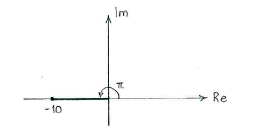Lösung 3.2:5a
Aus Online Mathematik Brückenkurs 2
(Unterschied zwischen Versionen)
K (Lösning 3.2:5a moved to Solution 3.2:5a: Robot: moved page) |
|||
| Zeile 1: | Zeile 1: | ||
| - | { | + | The argument of a complex number is angle of the line between the origin and the number measured with respect the positive real number axis. |
| - | < | + | |
| - | + | In this case, we see directly that | |
| + | <math>-\text{1}0</math> | ||
| + | has the argument | ||
| + | <math>\pi </math>. | ||
| + | |||
[[Image:3_2_5_a.gif|center]] | [[Image:3_2_5_a.gif|center]] | ||
| + | |||
| + | |||
| + | NOTE: All angles that correspond to the same direction differ by a whole number of turns, i.e. a multiple of | ||
| + | <math>2\pi </math>, and therefore we could have just as well answered | ||
| + | <math>-\pi </math>, | ||
| + | <math>3\pi </math>, | ||
| + | <math>5\pi </math> | ||
| + | etc. However, it is usual to give the argument between | ||
| + | <math>0</math> | ||
| + | and | ||
| + | <math>2\pi </math> | ||
| + | or between | ||
| + | <math>-\pi </math> | ||
| + | and | ||
| + | <math>\pi </math>. | ||
Version vom 15:46, 22. Okt. 2008
The argument of a complex number is angle of the line between the origin and the number measured with respect the positive real number axis.
In this case, we see directly that \displaystyle -\text{1}0 has the argument \displaystyle \pi .
NOTE: All angles that correspond to the same direction differ by a whole number of turns, i.e. a multiple of
\displaystyle 2\pi , and therefore we could have just as well answered
\displaystyle -\pi ,
\displaystyle 3\pi ,
\displaystyle 5\pi
etc. However, it is usual to give the argument between
\displaystyle 0
and
\displaystyle 2\pi
or between
\displaystyle -\pi
and
\displaystyle \pi .

